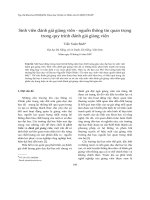Report signal and system
Bạn đang xem bản rút gọn của tài liệu. Xem và tải ngay bản đầy đủ của tài liệu tại đây (248.02 KB, 10 trang )
REPORT
SYGNAL AND SYSTEM
Lê Anh Ngọc
ID: 20174100
Class: TT.HTĐTĐT.01
SIGNAL CONTINOUSLY
I. Unit step function and unit ramp function
Exercise 1. Ustep function:
function u=ustep(t,a);
N=length(t);
u=zeros(1,N);
for i=1:N
if t(i)>=-a
u(i)=1
end
end
Exercise 2. Uramp function:
function y=uramp(t,b);
N=length(t);
y=zeros(1,N);
for i=1:N
if t(i)>=-b
y(i)=t(i)+b
end
end
Exercise 3.
+ 5u(t—2):
>>Ts=0.01;
>>t=[-10:Ts:10];
>>x1=5*ustep(t,-2);
>>plot (t,x1);
>>xlabel('x');
>>ylabel('y');
+ 3r(t+5) :
>>Ts=0.01;
>>t=[-10:Ts:10];
>>x2=3*uramp(t,5);
>>plot(t,x2);
>>xlabel('x');
>>ylabel('y');
+ y(t)=2r(t+2,5) -5r(t) +3r(t-2)
+u(t-4) :
>>Ts=0.01;
>>t=[-10:Ts:10];
>>y=2*uramp(t,2.5)5*uramp(t,0)
+3*uramp(t,-2)+ustep(t,-4);
>>plot(t,y);
>>xlabel('x');
>>ylabel('y');
+ y(t)=sin(t)*[u(t+3) -u(t-3)] :
>>Ts=0.01;
>>t=[-10:Ts:10];
>>y=sin(t).*(ustep(t,3)
-ustep(t,-3));
>>plot(t,y);
>>xlabel('x');
>>ylabel('y');
Exersice 4.
a.
>>Ts=0.01;
>>t=[-10:Ts:10];
>>y=0.5*uramp(-abs(t),4);
>>plot(t,y);
>>axis([-10 10 -0.5 2]);
b.
>>Ts=0.01;
>>t=[-10:Ts:10];
>>y=0.5*uramp(-abs(t),4)+1
-ustep(abs(t),-8);
>>plot(t,y);
>>axis([-10 10 0 3]);
II. Even and odd signals
Exercise 1.
function [ye,yo]=evenodd(y);
yr=fliplr(y);
ye=0.5*(y+yr);
yo=0.5*(y-yr);
end
Exercise 2.
>>Ts=0.01;
>>t=[-10:Ts:10];
>>y=2*uramp(t,2.5)5*uramp(t,0)+
3*uramp(t,-2)+ustep(t,-4);
>>evenodd(y);
>>yr=fliplr(y);
>>ye=0.5*(y+yr);
>>yo=0.5*(y-yr);
>>plot(t,ye,'r-.','linewidth',1);
>>hold on;
>>plot(t,yo,'g--','linewidth',1)
;
>>xlabel('t');
>>ylabel('y');
>>title('do thi ham so y(t)');
>>plot(t,y,'k','linewidth',1);
>>legend('yo','ye','y');
>>grid on;
III. Sum of periodic signals:
a.
>>Ts=0.01;
>>t=[-10:Ts:10];
>>x1=1+1.5*cos(2*pi*pi*t/10)0.6*cos(4*pi*t/10);
>>plot(t,x1);
>>xlabel('t');
>>ylabel('x1');
- is not a periodic signal because:
b.
>>Ts=0.01;
>>t=[-10:Ts:10];
>>x2=1+1.5*cos(6*pi*t)0.6*cos(4*pi*t/10);
>>plot(t,x2);
>>xlabel('t');
>>ylabel('x2');
- is a periodic signal because:
III. The energy and power of the signal:
>> syms t;
>> T=20;
>> u(t)=heaviside(t);
>> x(t)=exp(-t).*cos(2*pi*t).*u(t);
>> f=(abs(x(t))).^2;
>> E=int(f,t,-T/2,T/2)
E=
(exp(-20)*(2*pi^2 + 1)*(exp(20) - 1))/(2*(4*pi^2 + 1))
>> P=int(f,t,-T/2,T/2)/T
P=
(exp(-20)*(2*pi^2 + 1)*(exp(20) - 1))/(40*(4*pi^2 + 1))
IV. Time-Shifting, time-scaling and time-reversal
Exercise 1.
>>t=-10:0.01:10;
>>x=exp(-(abs(t)));
>>x1=exp(-(abs(t-2)));
>>x2=exp(-(abs(t+2)));
>>plot(t,x,'k','linewidth',2);
>>hold on;
>>plot(t,x1,'r','linewidth',2);
>>plot(t,x2,'g','linewidth',2);
>>legend('x(t)','x(t2)','x(t+2)');
>>title('x(t)=exp(-|t|)');
Exercise 2.
>>t=-10:0.01:10;
>>x=exp(-(abs(t)));
>>x1=exp(-(abs(2*t)));
>>x2=exp(-(abs(0.5*t)));
>>plot(t,x,'k','linewidth',2);
>>hold on;
>>plot(t,x1,'r','linewidth',2);
>>plot(t,x2,'g','linewidth',2);
>>legend('x(t)','x(2t)','x(0.5t)
');
>>title('x(t)=exp(-|t|)');
Exercise 3.
>>t=-10:0.01:10;
>>x=exp(-(abs(t)));
>>x1=exp(-(abs(-t)));
>>plot(t,x,'k','linewidth',2);
>>hold on;
>>plot(t,x1,'g--','linewidth',2
);
>>legend('x(t)','x(-t)');
>>title('x(t)=exp(-|t|)');









